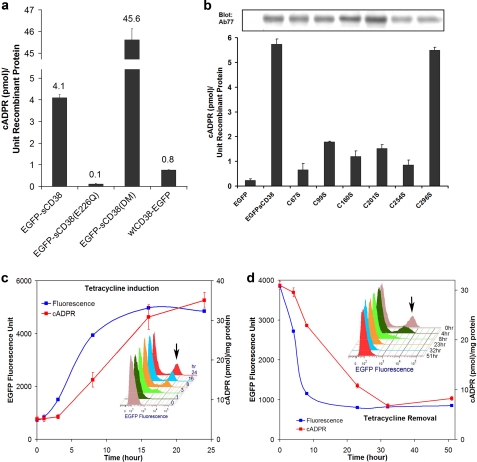FIGURE 3.
Engineered CD38 is biologically active. a, elevation of intracellular cADPR levels in cells expressing the engineered CD38. The intracellular cADPR levels in HEK293 cells expressing various forms of the engineered CD38 were measured. The enzymatically inactive mutation EGFP-sCD38(E226Q) served as a negative control. The cADPR levels shown were normalized to the protein expression levels of the engineered CD38 determined by immunoblotting (cf. b). b, intact disulfides are required for the activity of the engineered CD38. The intracellular cADPR levels in HEK293 cells expressing either EGFP-sCD38 or a cysteine mutant (C67S, C99S, C160S, C201S, C254S, or C296S) were measured and normalized to the protein expression levels of the engineered CD38 determined by immunoblotting (gel). All disulfides are critical for the activity of the engineered CD38 except the last one, Cys-287–Cys-296. c, tetracycline induction of EGFP-sCD38(DM) expression. NIH 3T3 cells were infected with lentivirus carrying the tetracycline-inducible vector containing EGFP-sCD38(DM). The inset shows flow cytometry analyses at various time points during the induction process and depicts the increasing number of cells expressing EGFP fluorescence of the fusion protein. d, time course of turning off the tetracycline induction. NIH 3T3 cells were induced with 1 μg/ml tetracycline for 24 h and washed with a culture medium free of tetracycline. The turn-off time course is shown. The inset shows flow cytometry analyses at the various times after tetracycline removal.

